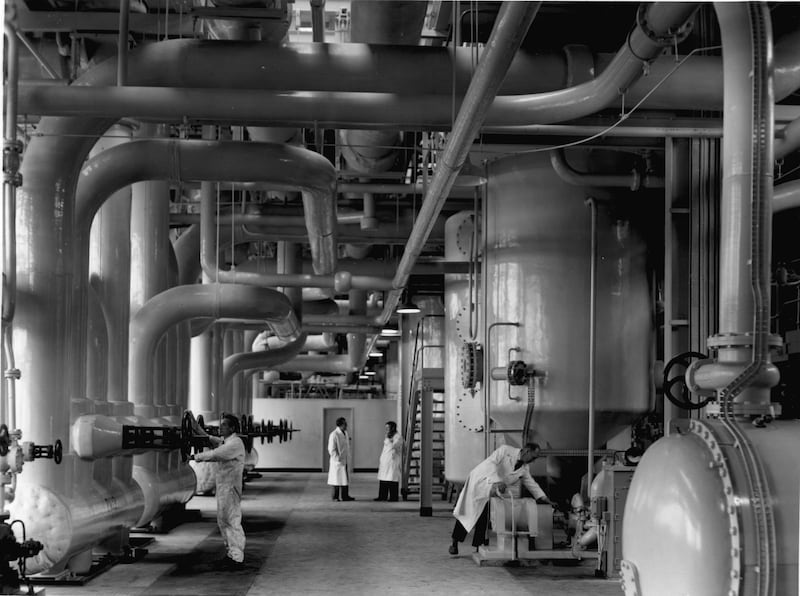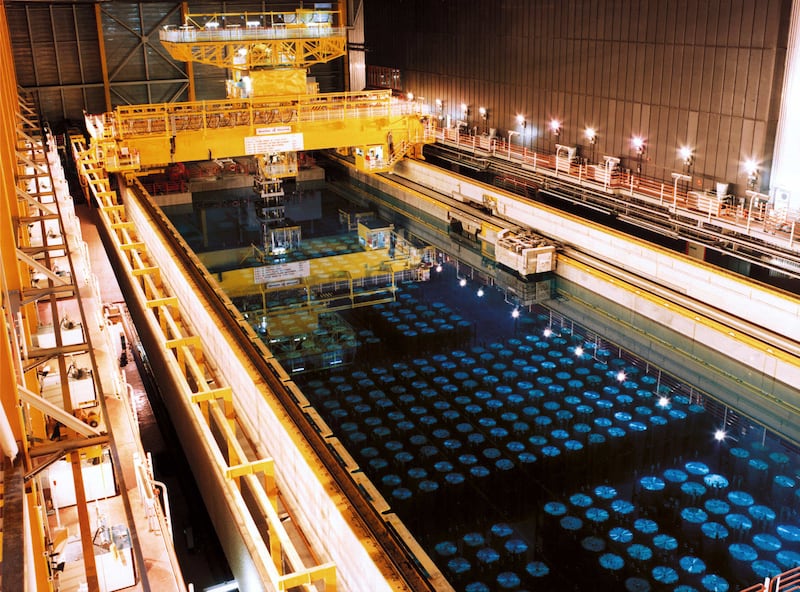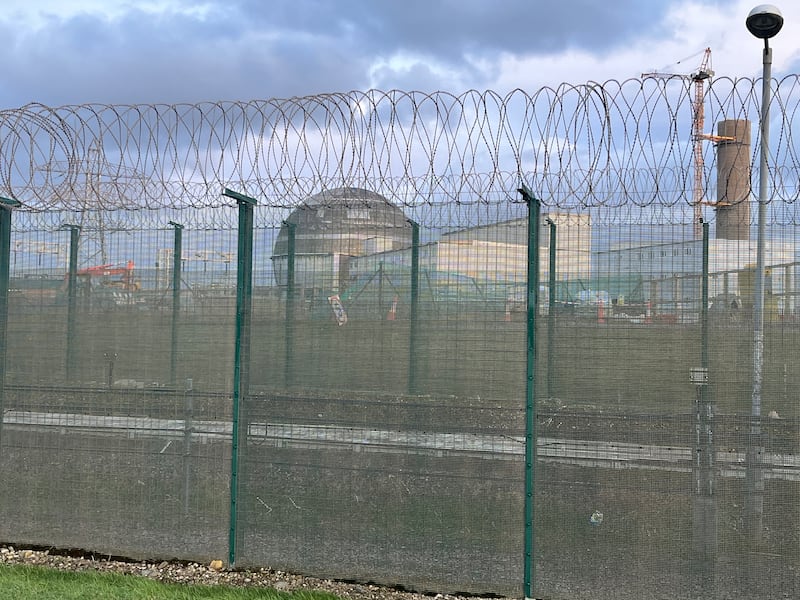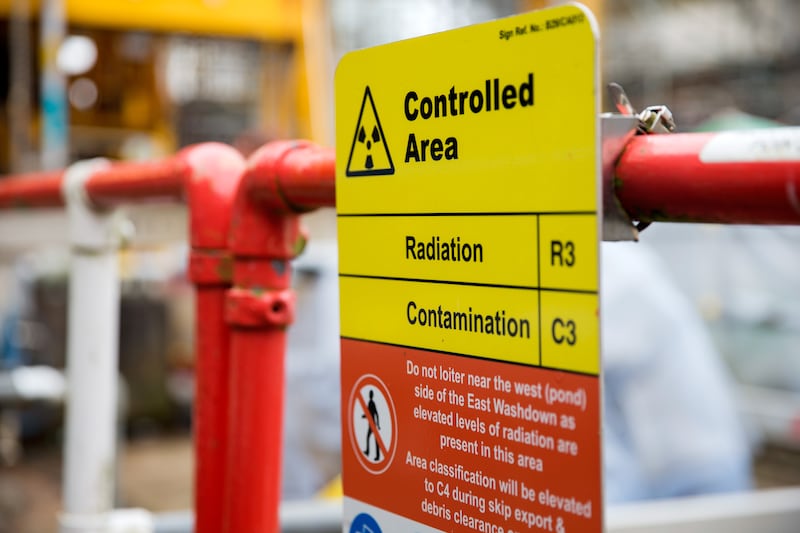A police vehicle with blue lights flashing races up uncomfortably close behind my car. It is January in northwest England: the Cumbrian countryside, 1.5km from the main gate of the Sellafield nuclear facility, the most toxic and dangerous site in western Europe. The officer gesturing to pull over seems to want a word.
As he approaches the car window, it is apparent he carries a gun. It isn’t drawn, but the way he struts seems calculated to draw attention to it. Seconds later another police car arrives. The two officers who emerge from it are more heavily armed. They hang back, but their ensemble looks similar to other officers seen earlier at Sellafield’s main gate. These ones are carrying automatic weapons.
They are all members of the civil nuclear constabulary (CNC), the specially trained force that guards Britain’s most sensitive nuclear sites. These are no bored mall cops pulling over people for kicks. Counterterrorism and prevention of espionage are high on their list of responsibilities.
The first officer is polite but firm as he explains why he pulled over the car. He spotted it parked near the side of the road close to Sellafield’s main gate.
“What were you doing outside your vehicle? Taking pictures? What for?”
He seems dissatisfied with the answer: that it was journalism. Then he clocks the accent.
“Ah, The Irish Times,” he says, studying the press identification he is given. He says he knows all about the history of Sellafield and Ireland. The Irish government had years ago sued Britain over safety fears at the site. Sellafield has loomed large in the Irish psyche since its 1980s heyday.
“What is your story about?” the officer asks. He gets a polite version of “mind your own business”. Undeterred, he presses further.
“Do you mind if I ask if it has anything to do with the recent coverage of Sellafield in the media?” he says, presumably referring to Guardian reports weeks earlier alleging that Sellafield’s IT systems had been hacked by Russia and China, and that the workforce culture was rotten – claims Sellafield has denied. The site’s regulator this week announced plans to prosecute Sellafield for alleged IT security offences.
The officer gets the same polite rebuff. It takes his colleagues another 15 minutes to verify the ID and car details. Then, just as it is time to go, Cumbria police also rush to the scene and want to know what’s going on. Eventually, with everyone satisfied, the time comes to depart, but only after a final warning from the CNC: “Your car is now logged in our system so you might be pulled over if it’s seen again.”

Sellafield: a byword for danger
The 700-acre Sellafield complex means different things to different people. To UK authorities it is a decommissioning hub being used to spearhead the clean-up of Britain’s early nuclear industry mistakes, made before the issue of long-term waste disposal was a priority.
In Ireland, about 180km away,Sellafield is mostly seen as a potential hazard, a byword for danger. A former reprocessing site for lethal spent nuclear fuel rods, it was also known for a now-defunct power plant that was tacked on, Calder Hall, but this was only ever a minor part of it. Reprocessing was the main activity.
These days, Sellafield is seen as more of a nuclear dump for the most radioactive material from all over the UK, with work ongoing in a 100-year, £134 billion (€156 billion) decommissioning project.
Yet another view of Sellafield: in the eyes of one nuclear industry source, the site is a “gravy train” for well-paid staff and big contractors. Sellafield Ltd, the site’s UK state-owned operator whose mission is to make it safe, spends more than £2.5 billion each year on the clean-up strategy. It is also a bustling 24-hour workplace for 11,000 people paid an average of €91,000 each annually.
Behind the razor wire, the gun-toting guards, 3.6m-high security fences and blast barriers, the Sellafield site is also a self-contained town with its own railway and 1,000 buildings. Some date back to the 1950s and are crumbling to bits, creating further hazards with the nuclear waste stored inside.
Sellafield is also the home to the world’s biggest stockpile of plutonium and four of the most hazardous buildings in Europe: two ageing nuclear silos with a history of leaks, and a pair of storage ponds filled with hazardous material. The most notorious pond, unit B30, is known as “Dirty 30″.
Since 9/11, however, Sellafield has also been viewed as a potential target for the UK’s enemies, including terrorists who might seek to attack it or acquire material for a so-called nuclear “dirty bomb”. This explains the recent intense focus on the facility after December’s Guardian allegations of cybersecurity hacks and claims by whistleblowers of bad staff morale, which critics say increase risk.
Its status also helps to explain the eagle-eyed approach of the CNC, exemplified in the car encounter described above. Eight weeks and one intense security vetting process later, The Irish Times returns to Sellafield, but this time with official clearance – the nuclear version of a Willy Wonka golden ticket.
The site’s critics, including the UK academic and radioactivity adviser to the Irish State, Dr Paul Dorfman, warn that the nuclear industry tries to dazzle outsiders with glossy public relations. Sellafield, meanwhile, says it is only trying to be honest and open about what it does.
The company, which answers to the UK government through the Nuclear Decommissioning Authority (NDA), confirms that The Irish Times is the first media outlet from the Republic to be granted recent access to the site and its inner sanctum, where the most dangerous nuclear material is handled.
Thirty years after U2′s Bono landed on a nearby beach in a Greenpeace protest, and almost 20 years after the Republic last tried to sue the UK over its safety risks, its existential relevance to Ireland remains. Sellafield hasn’t gone away, you know. The battle to keep it safe goes on.

‘Most radioactive sea in the world’
Sellafield overlooks the Irish Sea on the coast just beyond the western edge of the Lake District, the most undulating and, arguably, most beautiful part of England. The closest big town is the former coal port of Whitehaven, which centuries ago was a hub of trade to Ireland. Just more than an hour’s drive away is the closest city, Carlisle, an old fortress 15 minutes from the Scottish border.
Traditionally the area was prominent in mining and farming, while Cumbrian sausages are world-famous. For the last 75 years, western Cumbria has also been notorious as the capital of the British nuclear industry, which has also been in decline, although fresh investment in nuclear is planned by the UK.
Driving past the village of Egremont, which has grown prosperous in the hills above the facility, the luscious countryside suddenly falls away and the sprawling industrial hub below emerges from the surrounding farmlands, with the spring sun bouncing off its metal roofs for our official visit earlier this month.
We have no records or evidence to suggest that Sellafield Ltd networks have been successfully attacked by state or non-state actors
— Sellafield to The Irish Times this week
The visit is tightly controlled by the company, but it nevertheless grants access to all areas requested. These include the danger zone where the four most hazardous old buildings, including “Dirty 30″, are cramped together, and where one leaks daily bathfuls of radioactive liquid into the ground.
Sellafield also grants The Irish Times access to the old Thorp reprocessing plant, the Magnox East River fuel rod storage plant and the Sixep effluent facility that, like a nuclear kidney, filters radioactive pondwater that it is then pumped into the Irish Sea.
The tour is led by three senior Sellafield staff, including scientist Dr Rex Strong, the head of regulatory integration. He received an OBE in the king’s birthday honours list last year for his four decades in the nuclear industry. Strong was an outside adviser on the clean-up after the Fukushima nuclear disaster in Japan in 2014. He is also something of an Irish whisperer for Sellafield – since the 1970s he has been deployed to allay regular bouts of safety fears in the Republic.
With polite understatement, he says relations between Sellafield’s UK masters and the Republic were once “not good”. Then the company employed consultants in Dublin to reach out to local Irish interests. One of the biggest Irish concerns was over the dumping of nuclear pondwater into the Irish Sea, which earned it the dubious reputation as the “most radioactive sea in the world”.
Information-sharing improved after Ireland’s failed attempt to sue Britain in The Hague almost two decades ago. “Relations moved from hostile to something more adult,” says Strong, who used to sit on the bilateral UK-Ireland Contact Group on Radiological Matters that to this day still shares information on nuclear safety.

‘Bottomless pit of hell, money and despair’
“Sellafield has a really huge inventory of nuclear waste, and it’s the really nasty stuff,” says Dorfman, a nuclear expert at the University of Surrey. He is also a member of the radiation protection committee (RPAC) that advises the Republic through the Environmental Protection Agency. He also founded Nuclear Consulting Group, which lobbies against nuclear power – he actually favours renewables.
“The risks from the site are enormous. There is good reason why a former UK politician was recently quoted as saying it was a ‘bottomless pit of hell, money and despair’. You’ve got all these mind-boggling hazards and a philosophical debate over how does one live with this.”
Waste stored in Sellafield is categorised into material of low, intermediate and high levels of risk. The latter would kill anybody who came into contact with it almost immediately, say staff on the tour.
Much of the most dangerous materials are byproducts of the reprocessing of spent nuclear fuel rods, which basically means recycling them to extract more plutonium and uranium. The leftover liquids are particularly toxic. Sellafield stopped reprocessing fuel rods only in 2022.
Most of its waste was sent to the site from other British nuclear facilities, such as the 26 Magnox reactors that were carbon copies of the old Calder Hall power plant pioneered on the Sellafield site in the 1950s. That flow of waste ended when Magnox was phased out in 2018.
Later-era AGR nuclear reactors – there were 14 built in the UK, including the familiar so-called Golf Ball reactor at Sellafield – also sent their waste to Sellafield. There are about seven AGRs still operating which still send material, but only for “chopping up” and storing, and not for reprocessing.

About 80 per cent by volume is low-risk material, such as paper, pens and personal protective equipment used in radioactive areas. It is sent to a repository nearby. Ireland itself produces such low-level waste in facilities such as hospital X-ray departments.
When asked whether the Irish government had ever requested that Sellafield take the Republic’s radioactive waste, Strong replies, “We might have been asked, and we might have said no thanks.”
This week, the Department of the Environment in Dublin said low-level Irish waste is stored in dedicated rooms in hospitals and other facilities until the radioactivity depletes, then it is put in the rubbish. Anything imported in a “sealed” fashion with higher radioactivity is returned to sender after use.
About 19 per cent of the waste at Sellafield is intermediate risk and highly dangerous. It includes the solid casings from old nuclear fuel rods, which are chopped up, mixed with concrete and stored in special sealed containers. It also includes old equipment and skips that touched high-level waste.
About 1 per cent by volume is the really bad stuff: high-risk, most problematic material such as old fuel rods that take decades to cool down after being pulled out of nuclear reactors, and liquids that are left over from reprocessing before being solidified in glass.

‘Like emptying a wheelie bin with a teaspoon’
The first stop on the Sellafield tour takes us to Thorp, the 1990s facility that reprocessed waste on a commercial basis from reactors all over the world, including Japan. Material is stored in containers placed inside containers, similar to “Russian dolls”, according to one staff member. These are sunk in 8m-deep pools of shimmering blue water, which acts as a barrier to the radiation. The water is pumped in from the deepest lake in England, Wast Water in the Lake District.
Next we visit the most dangerous area on the site, the compound with the four oldest and most decrepit structures holding toxic materials. It includes the “Dirty 30″ surface pond and also B38, known as the Magnox Swarf Storage Silo. This has been leaking since at least 2019, and it is too dangerous to go inside to do repairs. Much of the material was dumped there for storage in the 1950s and 1960s.
“That material cannot be left in those buildings,” says Strong. “The structures were not built to modern standards. They are a hazard. We also don’t know exactly what is in them – record keeping wasn’t always great back then.”
This is one of the most dangerous sites in the world. That is not a question, it is a fact
— Dr Paul Dorfman, radioactivity adviser to the Irish State
No human can enter the inner core of these buildings – the environment is lethal. So Sellafield engineers are building elaborate, remote-controlled “fairground grabbers” to pluck the material out slowly over time and move it into special skips for safer storage in modern facilities.
“But it’s like emptying a wheelie bin with a teaspoon,” says Strong. “It could take until the 2050s.” There are 10,000 skips of material to remove from B38 alone – only 40 have been removed so far.
This compound with the most dangerous materials is behind several extra layers of security: airport-style personal checks, with individual pin-controlled access cards and higher razor-wire fences around individual buildings. Staff wear “active area” protective clothing, while everyone present wears personal radiation monitors that chip with greater frequency as the exposure increases. The signs say “highly radioactive area – no loitering”. So we don’t.
Inside the buildings, you hear a constant tick-tock noise similar to the radar sound on-board nuclear submarines in the movies. This sounds means the facility is operating safely. If it bursts into a siren, it is time to run. Each time you leave an active area, you must check your entire body with a hand-held device – a “frisk probe” – that crackles like a Geiger counter when it detects contamination.
One-third of Sellafield’s £2.5 billion annual budget is spent dealing with this tiny legacy compound. The buildings are old, leaky and too close together to implement better-engineered solutions.

Toxic workplace allegations
The recent allegations of IT hacking published in the Guardian prompted the UK government, through environment secretary Claire Coutinho, to seek an explanation. The authorities subsequently seemed to accept Sellafield’s rejection of the core of the allegations.
The Guardian said sleeper malware had been injected into Sellafield’s systems by groups linked to Russia and China as far back as 2015, and that some of the bugs may still be present. It also accused the company of not notifying everything to regulators.
This week – before charges related to cybersecurity were announced – Sellafield told The Irish Times: “We have no records or evidence to suggest that Sellafield Ltd networks have been successfully attacked by state or non-state actors. Our monitoring systems are robust and we have a high degree of confidence that no such malware exists on our system.”
The Guardian had stood over its report, even after Sellafield’s chief executive, Euan Hutton, denied the accusations on the BBC. The UK’s Office for Nuclear Regulation had denied any foreign hacking and had implemented “special measures” for monitoring Sellafield for weaknesses in its IT system.
[ Government pressed to reveal how much it knew about reported Sellafield leakOpens in new window ]
Dorfman says the hacking allegations “give pause for thought”. He also referred to an alleged risk from a “toxic workplace culture” at the site. The Guardian said many current and former staff told it of concerns over bullying, harassment and belittlement, and that some people had taken their own lives.
Sellafield has denied any link between the plant and suicide, but has acknowledged issues over workplace culture in the past, particularly after a companywide 2018 staff survey that pointed to concerns over morale.
The Irish Times has seen a staff video made following the survey by then-chief executive Paul Foster, where he says “what was going in our business ... shamed me”. He calls for an end to outdated “banter”. The Irish Times has also seen internal emails from senior staff that refer to poor work culture on the site.
Sellafield said this week it had worked hard to address work culture issues since 2018 and does not tolerate bad behaviour. Yet a former HR consultant who was brought in to help address issues within the company, Alison McDermott, was sacked by the company in 2018 shortly after raising concerns. She later took a whistleblower case against the company and sued it at an employment tribunal, but lost. She is now being pursued for huge costs related to her action against the company.
McDermott spoke at a conference last year in which she insisted “there were really serious and systemic issues around bullying and harassment” at Sellafield, which had the effect of making the nuclear site more dangerous. She spoke publicly of one young graduate who was allegedly told by a rogue staff member that she needed a “corrective rape”.
Sellafield insists “there is no place” for any harassment or bullying on the site and urges anyone with evidence of it to come forward.
The company also says it is being open about the nuclear leaks and has a plan to manage them. Irish State officials got a tour of Sellafield in July 2022 and 2023, and are expected to visit again this year. When asked whether it had concerns following the recent reports of cyber hacking, the Department of the Environment says it is satisfied it is being kept up to date.
Minister for the Environment Eamon Ryan has told the Dáil there are currently no concerns about Sellafield from the Republic. The Environmental Protection Agency says it believes risks to the State are “negligible”.
Dorfman, meanwhile, says he is struggling to get the RPAC radiation protection committee, which is composed of Irish- and UK-based advisers, to show any interest in discussing issues at Sellafield.
“This is one of the most dangerous sites in the world. That is not a question, it is a fact. It is critical that RPAC puts it back on the Irish agenda.”
A potential long-term solution is to bury Sellafield’s nuclear waste for thousands of years deep underground in bunkers beneath hard rock, although one industry cynic remarked that this would end the need for the lucrative disbursal of so much UK taxpayers’ cash on handling it on the surface.
Sellafield said work to find a community willing to accept such a “geological disposal facility” is ongoing, and suggested Cumbria could yet be an option.
The litany of debates about Sellafield could last almost as long as some of its radioactivity.
- Listen to our Inside Politics Podcast for the latest analysis and chat
- Sign up for push alerts and have the best news, analysis and comment delivered directly to your phone
- Find The Irish Times on WhatsApp and stay up to date



















